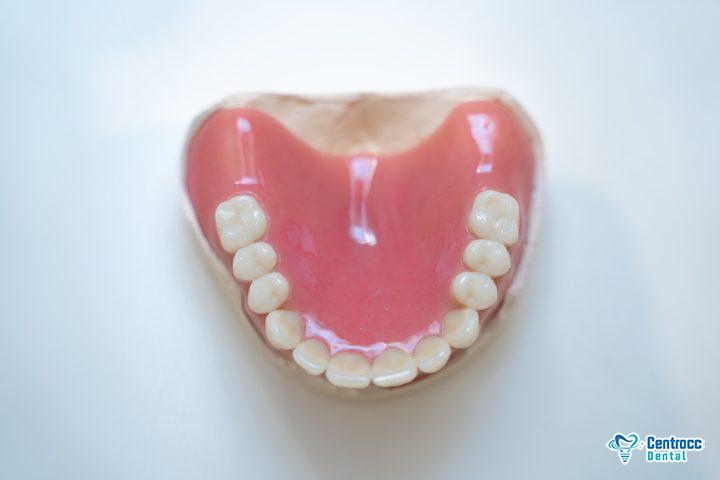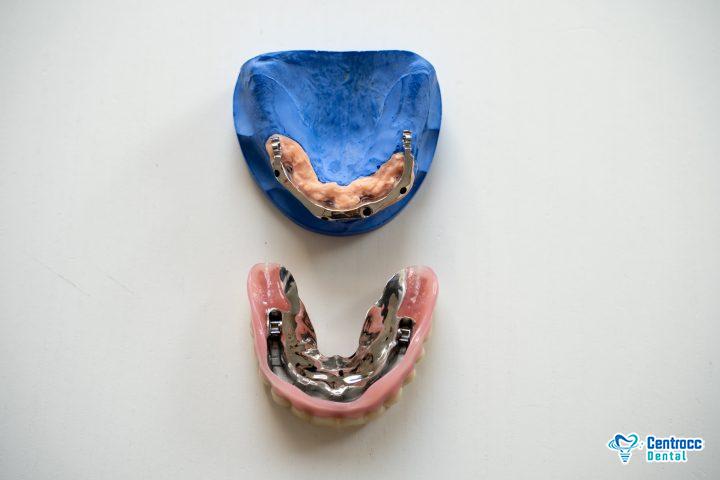Dentures are removable prosthetic devices made of special acrylic material (in some cases reinforced with a metallic base) designed to replace the missing teeth. By replacing the missing teeth, dentures can improve chewing ability, pronunciation and general self-esteem as the presence of the teeth gives a healthy appearance to the face.
If the denture is used on a completely edentulous jaw, we are talking about a complete denture. If the denture replaces only a few missing teeth, it is a partially removable denture.
Opposed to dental bridges and crowns, dentures are not fixed devices, they are supported by the surrounding soft and hard tissues of the oral cavity.
There is no risk of wearing dentures, but maintaining a good oral hygiene and cleaning habits are essential to keep them a long-lasting solution for tooth loss.
Types:
Complete dentures:
Used to replace all the teeth of the patient on a single arch or both arches. They cover a much larger area of the oral mucosa than fixed prothesis, thus getting used to them can take longer and patients can experience minor disturbances in taste perception and speech.
Partial dentures:
Used in the absence of some teeth. They are fixed to the existing teeth with a special fastener. The fastening element can be a plastic or metal clips, or some special “precision attachments”. If the missing teeth cannot be replaced with an implant, partial dentures are suitable alternatives.
Implant supported dentures (overdentures):
Dentures can be supported by implants as well; in which case the implants greatly increase the stability of the denture.
Depending on the number and position of the implants, the size of the base plate of the denture can be significantly reduced, making the denture anchored on the implants a much more comfortable fit as opposed to a complete denture.
Depending on the number and position of the dental implants, there is the possibility to use bar-retained dentures and so called Locator-retained dentures. For bar-retained dentures we usually use 4 dental implants in the frontal region so that they are splinted with a bar. This special bar gives an extra stability to the denture, so the size of the whole restauration can be smaller. (for instance there is no need for palatal extension, cause the retention does not come from the vacuum-effect. The Locators also give extra stability to the denture, but they are individual abutments without splinting.
The stability of dentures supported by implants is much better than that of traditional dentures. Their wearer practically does not even notice it, as it stays in place during chewing, talking, smiling and only needs to be taken out for cleaning. Patients are often frightened when they hear the word “denture” and reject it immediately. Our experience shows however that all our patients are maximally satisfied with these types of dentures. In some cases, these dentures provide a more ideal solution than fixed bridges made for dental implants.
Benefits:
- In addition to the obvious aesthetic benefits, there are, of course, functional advantages of replacing missing teeth.
- After losing teeth, the face “collapses” and the muscles contract. This is the reason why patients who are toothless or have a lack of teeth in the chewing region look wrinkled and older. The base of the denture can provide adequate lip-support (sometimes fixed restorations can not)
- Atrophy appears in the jawbones after the loss of teeth, and the lower jaw typically moves forward compared to the upper one.
- With a well-customized denture, missing teeth can be replaced and the vertical dimension of the bite can be restored. By setting the correct occlusion (bite), the jawbones can be arranged in the correct position.
- All this allows the patient to have a younger appearance, and any joint problems that may exist can be also eliminated. Dentures, of course, restore proper chewing functions as well.
- It can be more cost effective
Disadvantages:
- Removeable dentures must be removed at least twice a day for cleaning.
- Getting use to the dentures can cause difficulties for a few days after the delivery, as the denture takes up more space in the mouth than either the teeth or a fixed denture (e.g., crown, bridge).
- Under certain anatomical conditions – especially at the lower jaw in case of a severely atrophied jawbone – the stability of a complete denture will never be ideal without the use of denture-fixing creams.
.


